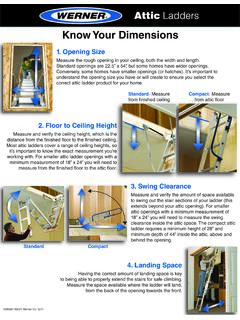Transcription of PC-DMIS CMM Operation Instruction for Manual Measurement
1 PC-DMIS CMM Operation Instruction for Manual Measurement C-DMIS CMM Operation Instruction for Manual Measurement (IE 415 project example) Lucas Tsai 1. Pre-Starting Check: 1. Start up machine 2. Check air is on 3. Controller on 4. PC turn on, turn on PC-Dmix-online program 5. Push machine start button on the remote 6. Then click ok on the PC-dmix window to let Machine go to home position 7. You can start to use PC-DMIS . Start new part program, only one program can be online to use CMM ( others are off-line).
2 Unit can be inch (for IE 415) or mm as unit. 8. Select T1A0B0 as basic configuration to Click measure to calibrate 9. Calibrate will always rewrite the prob profile for current condition. 10. Edit tool is to make sure you are using right Qual sphere, which is the white ball on the table. We use calibration step to check if our probe condition is well ( including tip (ruby ball) surface and probe length). 11. Select Yes to recalibrate everything 12. select ok and then bring probe to center top (center in X-Y) 13.
3 Then touch the top of the Qual tool, click continue and the CMM will start the calibration automatically 14. Then back to Prob Utility to click result .STDEV <= is good enough 2. Import CAD model REMEMBER THIS STEP CAN T BE UNDO, SAVE YOUR PROGRAM AS ANOTHER FILE. We can export Esprit program to .Igs file and have PC-DMIS to read it by File/Import/Igis file. The CAD will be taken in. If you do this before alignment, you can find CAD=Part button in the Alignment Utility window. By aligning the part exactly like the CAD, you can just click this button to join them together.
4 If you try to do this after the alignment, go through Operation /Graphic Display Window/CAD equals Part. 3. Alignment work 1. Measure a plane ( at least 3 hits) to do first alignment PLN1 =FEAT/PLANE,RECT,TRIANGLE , , , , , , , , , , MEAS/PLANE,4 HIT/BASIC,NORMAL, , , , , , , , , ,USE THEO = YES HIT/BASIC,NORMAL, , , , , , , , , ,USE THEO = YES HIT/BASIC,NORMAL, , , , , , , , , ,USE THEO = YES HIT/BASIC,NORMAL, , , , , , , , , ,USE THEO = YES ENDMEAS/ 2.
5 Align plan1 to Z-plus -> level. This constrain x and y axis rotation. 3. Then we can go ahead to measure 2D feature (Line, clrcles) and use them to align the rest DOF. 4. First is Rotate: use lin1 to rotate to x plus about Z plus . This constrains z axis rotation. 5. Second is to do Origin . Use the center of circle to give x and y location and plane to give z location. By this it constrains all translations. 6. The alignment is now fit the part datum. 4. Take measurements The example is the IE 415 holder project Plane HighPlane LowLine Y Circle LargeCircle rightCircle left X Y Z+3 1.
6 The CMM can make automatic guess when you select ? before Measurement . If the guess is wrong, check for hadeling the error. 2. Go ahead to measure the features like line, circle and plane .., etc. We will use them to construct dimension such as distance , position later. 3. After taking enough hits for features (ex: line), press done in remote to let CMM know a feature should be created. Also, it will be added to the Edit Window as part of the code. 5. Establish dimension 1. After all features are measured and created, use the feature to construct the dimension such as location, angularity, distance , flatness.
7 2. For example, to measure 2D distance between Line Y and circle left 3. First select distance from the tool bar. 4. The setup window looks like the above. Select circle (first) and line (second) and then project to the vector that is Parallel to X axis . Surely you can also choose Perpendicular to Y axis which is the same idea. 5. This is the output code in Edit Window: DIM DIST6= 2D distance FROM CIRCLE CIRLEFT TO LINE LINY PAR TO XAXIS, NO_RADIUS UNITS=IN ,$ GRAPH=ON TEXT=OFF MULT= OUTPUT=BOTH AX NOMINAL +TOL -TOL MEAS DEV OUTTOL M ----#---- 6.
8 This is report view in report Window Turn Off 1. Save file and turn off program window (graphic and Edit) 2. Turn off PC dmis 3. Turn off controller (Control off, power off) ======================================== =================== Note1: Change Measurement guess If originally our guess type is line but actually measure a circle: LIN2 =FEAT/LINE,RECT,UNBND , , , , ,0 , , , , ,0 MEAS/LINE,4,WORKPLANE HIT/BASIC,NORMAL, , , , , ,0, , , ,USE THEO = YES HIT/BASIC,NORMAL, , , , , ,0, , , ,USE THEO = YES HIT/BASIC,NORMAL, , , , , ,0, , , ,USE THEO = YES HIT/BASIC,NORMAL, , , , , ,0, , , ,USE THEO = YES ENDMEAS/ Goto: Edit/Override guess/ circle to fix it to circle

